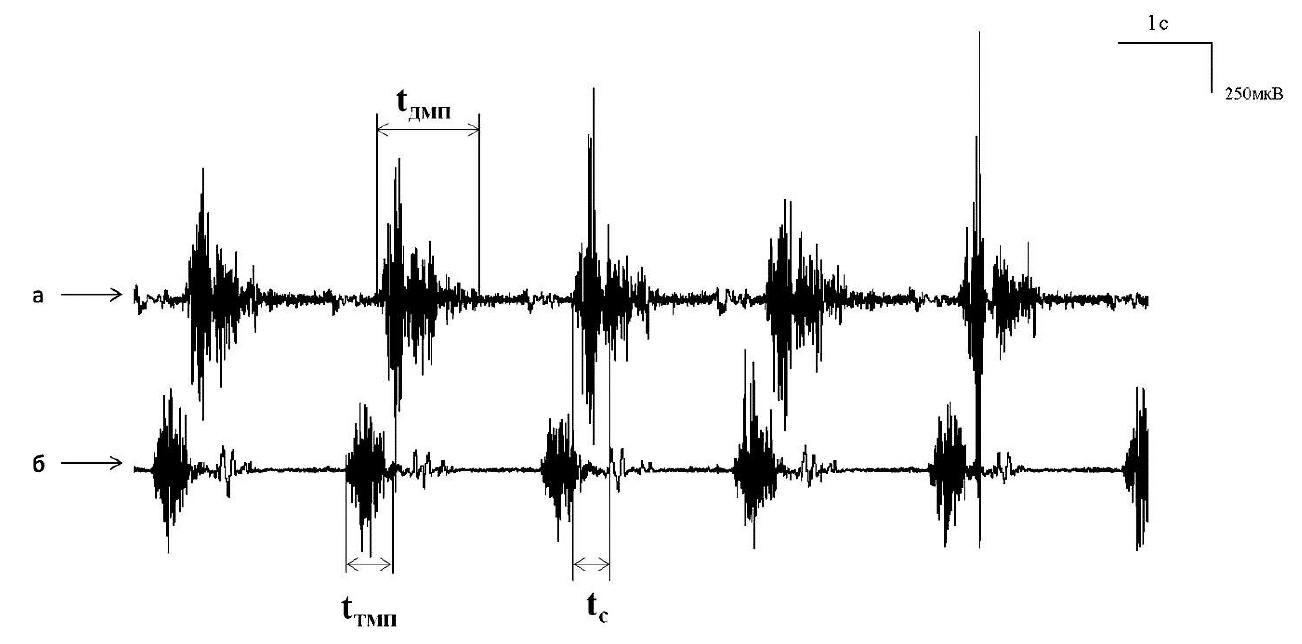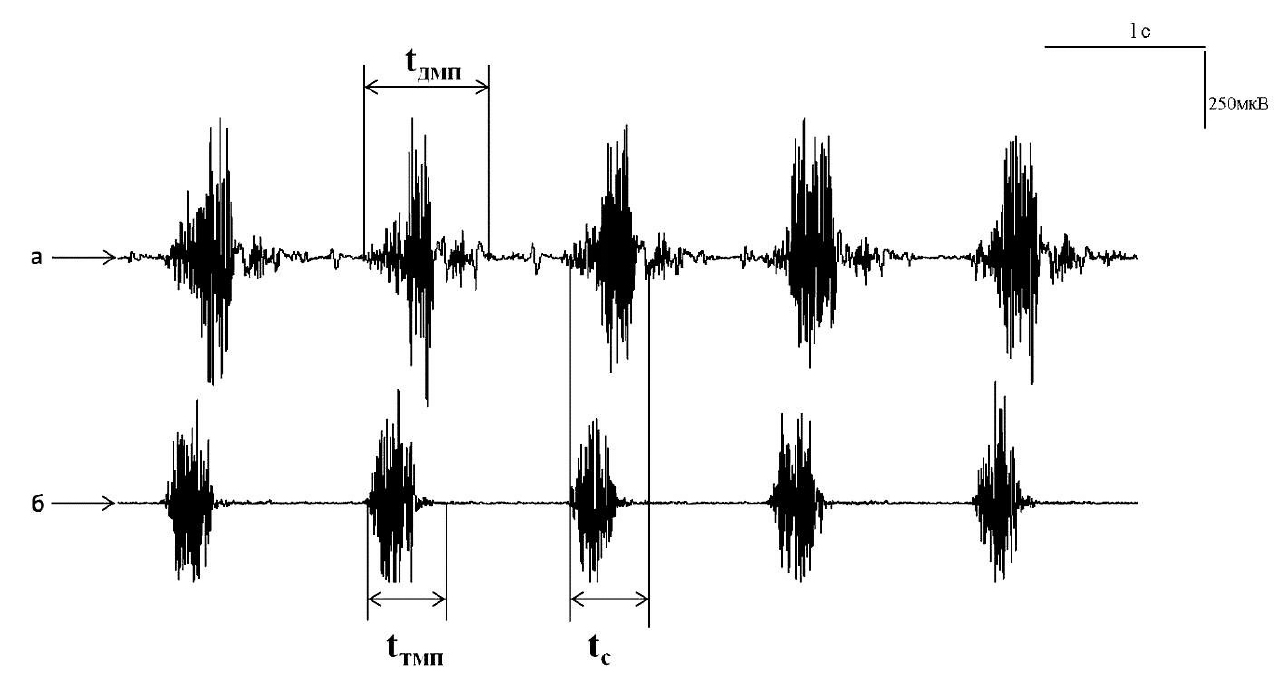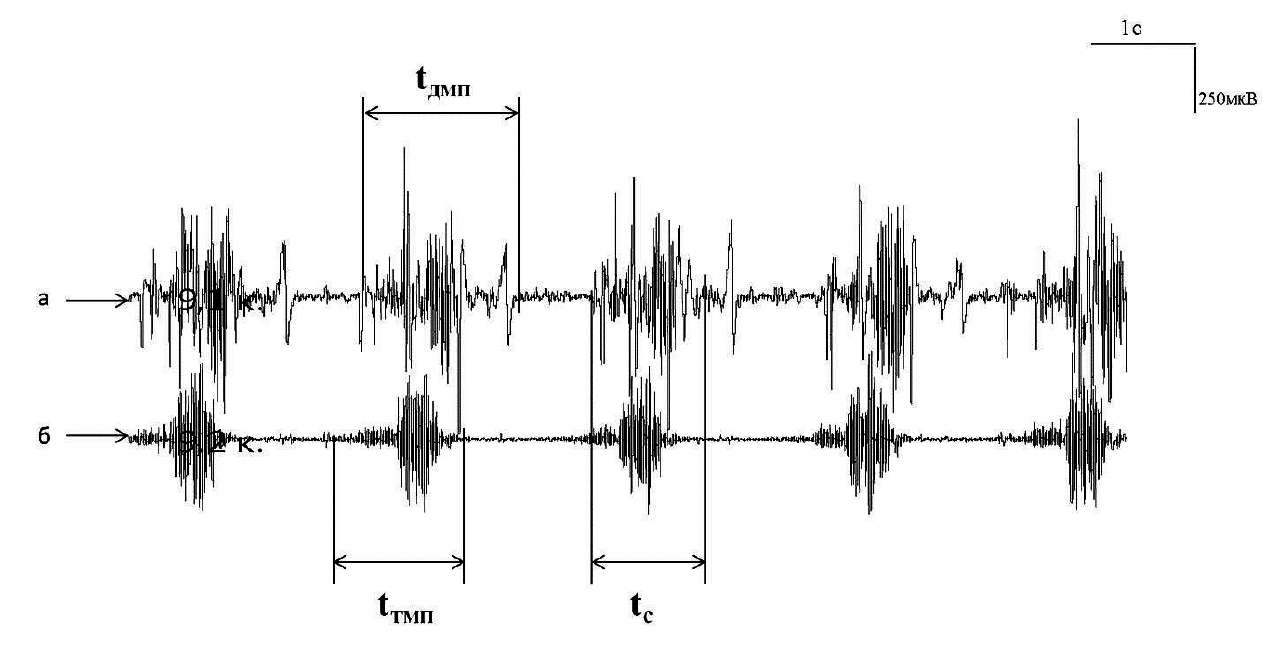Electromyographic ratings of inter-muscular interactions in athletes
Фотографии:
ˑ:
PhD, Associate Professor S.V. Vlasova1
Dr.Med., Associate Professor V.I. Khodulev2
Dr.Hab., Professor G.N. Ponomarev3
1Polessk State University, Pinsk
2Republican Research and Clinical Center of Neurology and Neurosurgery, Minsk
3Herzen State Pedagogical University of Russia, St. Petersburg
Keywords: bioelectrical activity, electromyography, inter-muscular interactions, rehabilitative diagnostics, adaptation.
Background. The modern medical service systems in the physical culture and sport sector are being persistently improved to meet the needs of the main service consumers and implement innovative technologies in the sector. Many system elements are being modified including the athletes’ functionality rating methods, the athletic progress monitoring and expert rehabilitative service coordination mechanisms; and the athletes’ response rates and reserve capacities are also subject to permanent changes [1, 6, 8].
It is a matter of common knowledge that sports on the whole and elite sports in particular are highly demanding to the athletes’ functionality and may be even detrimental for health [1, 4, 5].
It should be noted at the same time that the existing long-term training and competitive process management systems are objectively and subjectively challenging for some forms of progress monitoring, with the progress monitoring data relevance being different for the athletes of different skill levels [2]. The existing monitoring systems are dominated by the health-protection and potential disorder prevention and correction methods largely focused on the cardiovascular system functionality with notably less priority being given to the other areas and systems, including the neuromuscular system functionality [10]. However, as reported by some recent studies, cardiovascular system diseases account for 22.7% of the total samples; chronic musculoskeletal system diseases were found in 74.3%; and the peripheral nervous system diseases in 65.9% of the cases under study, being second only to the post-injury disorders diagnosed in 80% of the tested athletes [9].
Long-term athletic training is known to activate the relevant adaptation mechanisms in every body system including the neuromuscular system elements when growing physical loads are applied in the training process. It is the harmonization degree of different components of the adaptation process that is known to determine both the actual efficiency of a competitive activity and potential fatigue, over-stresses and injuries in the process [1, 3, 6, 9]. Therefore, due priority is to be given to studies of the neuromuscular system performance specifics, particularly in the cyclic sport disciplines that require certain motor skill stereotypes being developed in the athletes.
Of special importance for the athletic performance progress control, training process management and long-term phased selection activity are the qualitative rating criteria to rate the above system performance; and electromyography-based diagnostics are commonly acknowledged as beneficial for the neuromuscular system activity rating studies [7, 8]. However, applied sport electromyography has been seldom in use by the medical and biological support service in the athletic training process that is explainable by the shortage of specific equipment and specialists and high labour-intensity of the tests, the situation being further complicated by the lack of reliable muscular performance rating criteria of practical importance for the coaches and athletes.
The methodologies proposed herein are mostly focused on the amplitude- and frequency-related criteria of muscular activity including the spectral amplitudes and average frequencies of the pattern spectra of the obtained electromyograms (EMG) with no consideration for the interactions of different elements in the system [7, 8]. It should be also noted that the subject athletes’ performance was mostly tested beyond the actual competitive loads, and this fact may be viewed as disadvantageous as far as the practical benefits of the study findings are concerned.
Objective of the study was to improve the expert rehabilitative diagnostic procedures based on the rowers’ shoulder muscle group harmonization profiles using the sport-specific load qualitative rating criteria.
Methods and structure of the study. Subject to the study were 48 rowers who gave their informed consent for participation. The study was performed at the Medical Education Centre and the Rowing Base of Polesye State University and at few other sport bases where the education and training sessions of the subject athletes were scheduled in the study period.
The study data were obtained using a 4-channel Neuro-MVP-4 Electromyograph (made by Neurosoft, Russia) system with the induced potential testing capacity. The study was designed to record bioelectrical potentials in motor points of the musculus biceps brachii and musculus triceps brachii of the subject rowers, with the skin EMG tests being applied. The skin-mounted pickup electrodes were placed at standard (3.5 cm) distances and fixed using special plates and rubber tapes on the shoulders of the athletes, with the skin contact quality being assured by the relevant software tool. The reference electrodes were fixed in distal areas over tendons of the subject muscles; and the grounding electrodes were fixed on the forearms. The aggregate EMGs were recorded in the standard rowing motor sequence performance process with rated load on the Concept-II rowing simulator unit during the training sessions.
The zero-hypothesis (of the tested data distribution having no difference with the theoretically expected normal distribution) was checked using W-criterion of the Shapiro-Wilk test. The no-difference hypothesis in application to the compared groups on the whole was tested using a dispersion ANOVA analysis; and multiple comparisons of the skill groups of the subject athletes under the Post-hoc analysis system were made using the Newman-Keuls tests adjusted as required by the Bonferroni approach.
Study results and discussion. The rowing movement sequence performed on the Concept-II rowing simulator unit was dominated by the forearm cyclic extension/ flexion movements in the elbow joints. In the process of adaptation to the physical loads, the alternating extension and flexion muscle activation/ relaxation cycles were expected to show an evolution towards energy efficient patterns.
We would define harmonization of the musculus biceps brachii and musculus triceps brachii flexion/ relaxation as the duration of the time-harmonized bioelectrical activity of the musculus biceps brachii and musculus triceps brachii in the forearm extension/ flexion process indicative of an improvement in the motor activity central regulation process.
In the sport-specific movement sequence performance on the rowing simulator with the loads rated within the range of 280-320 W, and with the aerodynamic resistance ratio estimated at 6.5, the tests resulted in the duration of the time-harmonized bioelectrical activity of the working musculus biceps brachii and musculus triceps brachii being registered with millisecond accuracy.
The highly skilled rowers were tested with the duration of the time-harmonized bioelectrical activity of the working musculus biceps brachii and musculus triceps brachii being under 300 ms (see Figure 1), and this rate we interpreted as characteristic of a high harmonization degree of the musculus biceps brachii and musculus triceps brachii action/ relaxation process.

Figure 1. Bioelectrical activity electromiograms (EMG) of musculus biceps brachii and musculus triceps brachii of L., International Class Master of Sport; with a – meaning musculus biceps brachii EMG; b – musculus triceps brachii EMG; tдмп – musculus biceps brachii flexion time; tтмп – musculus triceps brachii flexion time; tс – duration of time-harmonized bioelectrical activity of working musculus biceps brachii and musculus triceps brachii. The EMG analysis gave tc=218 ms which is a high harmonization rate
In case of the athletes tested with mean bioelectrical activity harmonization rates, the duration of the time-harmonized bioelectrical activity was found to vary from 400 to 700 ms (see Figure 2).

Figure 2. Bioelectrical activity electromiograms (EMG) of musculus biceps brachii and musculus triceps brachii of T., Candidate for Master of Sport in rowing; with a – meaning musculus biceps brachii EMG; b – musculus triceps brachii EMG; tдмп – musculus biceps brachii flexion time; tтмп – musculus triceps brachii flexion time; tс – duration of time-harmonized bioelectrical activity of working musculus biceps brachii and musculus triceps brachii. The EMG analysis gave tc=435 ms which is a mean coordination rate
When the duration of the time-harmonized bioelectrical activity was higher than 700 ms, the athletes were diagnosed with poor muscular action harmonization rates (see Figure 3).

Figure 3. Bioelectrical activity electromiograms (EMG) of musculus biceps brachii and musculus triceps brachii of N., unqualified rower; with a – meaning musculus biceps brachii EMG; b – musculus triceps brachii EMG; tдмп – musculus biceps brachii flexion time; tтмп – musculus triceps brachii flexion time; tс – duration of time-harmonized bioelectricsl activity of working musculus biceps brachii and musculus triceps brachii. The EMG analysis gave tc=1030 ms which is a poor harmonization rate
Conclusion. We have developed and offered a qualitative electromyography-based rating method to rate the musculus biceps brachii and musculus triceps brachii action/ relaxation process harmonization in rowers. The method makes it possible to objectively and quantitatively rate the working musculus biceps brachii and musculus triceps brachii harmonization degrees in competitive rowing and thereby notably increase the efficiency of the education and training load dynamic control and process management; with the method being also beneficial for a variety of expert studies and sport selections at different stages of athletic career.
References
- Babaev M.A. Osobennosti professional'noy sportivnoy deyatel'nosti i risk razvitiya uskorennogo stareniya (Features of professional sport activity and risk of accelerated aging) / M.A. Babaev et al.// Uspekhi gerontologii. – 2010. – № 4. – P. 652-656.
- Vlasova S.V. K voprosu o sportivnom dolgoletii (Sport longevity) / S.V. Vlasova // Zdorov'e dlya vsekh: Mater. V mezhdunar. nauch.-prakt. konf., Pinsk, 25-26 aprelya 2013 g.: v II ch. (Health for All: Proc. V Intern. res.-pract. conf, Pinsk, April 25-26, 2013; in 2 parts) / National Bank of the Republic of Belarus [et al.]; ed. K.K. Shebeko [et al]. – Pinsk: PolesSU, 2013. – V. II. – P. 153-156.
- Vlasova S.V. Neyrofiziologicheskie aspekty adaptatsii sportsmenov k fizicheskoy nagruzke (Neurophysiological aspects of athlete's adaptation to physical activity) / S.V. Vlasova, V.V. Shantarovich, E.G. Kallaur // Adaptatsiyni mozhlivosti ditey ta molodi: materiali X Mizhnarodnoi naukovo-praktichnoi konferentsiii, prisvyachenoi 95-richchyu utvorennya kafedri biologii i osnov zdorov’ya PNPU imeni K.D. Ushinskogo, Odesa, 11-12 verasnya 2014 roku (Adaptive opportunities of children and youth: Proc. X International res.-pract. conference devoted to the 95-year anniversary of department of biology and health foundations in Ushinskiy PNPU , Odessa, 11-12 verasnya 2014) /Ch. ed. A.I. Bosenko. – Odessa: Yuridichna literatura, 2014. – V. 2 . – P. 18-23.
- Dorofeeva E.E. Sovremennyie predstavleniya o metodakh reabilitatsii i metabolicheskoy zashchity sportsmenov vysokogo klassa (Modern ideas of methods of rehabilitation and metabolic protection of elite athletes) / E.E. Dorofeeva, I.V. Karpenko // Theory and practice of physical education. – Donetsk: DonNU. – 2013. – № 2.– P. 133-138.
- Kashuba V.A. Profilaktika i reabilitatsiya v sovremennom sporte: problemy i puti ikh resheniya (Prevention and rehabilitation in modern sport: problems and solutions) / V.A. Kashuba, S.S. Lyugaylo // Metodologiya, teoriya i praktika v sovremennoy meditsine, biologii, farmatsevtike, veterinarii: Mater. Mezhdunar. nauch.-prakt. konf. (Methodology, the theory and practice of modern medicine, biology, pharmacy, veterinary medicine: Proc. Intern. res.-pract. conf. (Novosibirsk, Russia, October 1, 2013). - Novosibirsk: Sibprint, 2013. – P. 47-56.
- Makarova G.A. Analiz faktorov riska kak osnova profilakticheskoy sportivnoy meditsiny (Analysis of risk factors as basis for preventive sport medicine) / G.A. Makarova, S.Yu. Yurev // Lechebnaya fizkul'tura i sportivnaya meditsina. – 2015. – № 4 (130). – P. 14-19.
- Novikov L.V. Osnovy veyvlet-analiza signalov: ucheb. posobie (Basics of signal wavelet analysis: study guide) / L.V. Novikov. – St. Petersburg, 1999. – 152 p.
- Pryanishnikova O.A. Sportivnaya elektroneyromiografiya (Sport electroneuromyography) / O.A. Pryanishnikova, R.M. Gorodnichev, L.R. Gorodnicheva, A.V. Tkachenko // Teoriya i praktika fizicheskoy kultury. – 2005. – № 9.
- Chashchin, M.V. Professional'nye zabolevaniya v sporte: nauchno-prakticheskie rekomendatsii (Occupational diseases in sport: research and practice advice) / R.V. Konstantinov, M.V. Chashchin. – Moscow: Sovetskiy sport, 2010 . – 176 p.: il.
- Chelnokov V.A. Innovatsionnye puti meditsinskoy profilaktiki bolezney pozvonochnika v sporte vysshikh dostizheniy (Innovative methods of medical prevention of spine diseases in elite sport) / V.A. Chelnokov // Vestnik sportivnoy nauki. – 2008. – № 4. – P. 93-96.
Corresponding author: g-ponomarev@inbox.ru
Abstract
The article explores some matters of neuromuscular activity in the rowing sport. Subject to the study were 48 rowers. The study was designed to record bioelectrical potentials in motor points of the musculus biceps brachii and musculus triceps brachii of the subject athletes, with the skin electromyograms being applied to obtain data profiles of the athletes performing the standard motor sequences with rated loads on the Concept-II rowing simulator unit during the training sessions. Subject to the analysis were the electromyographic patterns of the above shoulder muscles under rated loads on the rowing simulator. The study data gave the means to identify some important trends and offer a quantitative electromyographic rating method to profile the action/ relaxation cycles of the musculus biceps brachii and musculus triceps brachii. The newly developed method makes it possible to obtain objective process rating data based on the harmonization degrees of the musculus biceps brachii and musculus triceps brachii action/ relaxation cycles, the data being beneficial for the dynamic process control and the education/ training load management and correction process efficiency improvement; in addition, the performance rating data may be beneficial for a variety of expert studies and sport selection at different stages of athletic career.




